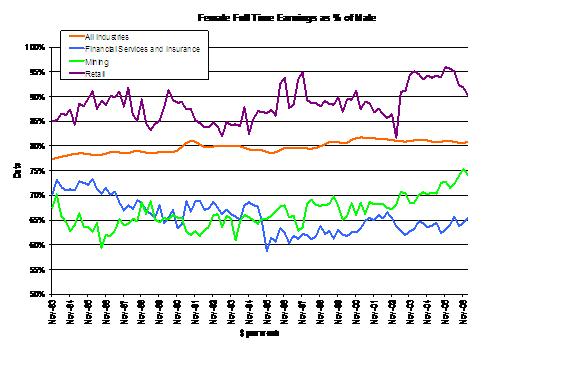There was the regularly quarterly article today, following the release of the latest labour force statistics, about how women earn less than men, with the gap narrowing very slightly in the last quarter. Varying reasons were given (Joe Hockey, for the government, drawing a long bow and claiming work choices helped women, versus two economists who said it was more likely to be about low wages increasing with the Fair Pay Commission).
My eye was drawn to the table of differential wages by industry, which I had never seen before. To my surprise, my own industry, financial services and insurance, had the largest gap of all. I created this graph, just to look at some of the others.
The industry with the most even distribution of earnings is the retail, and the industry with almost as much inequality as the financial services industry is the mining industry. You can see from the fluctuations in the graph that the data isn’t as good when you get down to industry level, but it’s got some fairly clear messages.
The financial services industry is probably so unequal because of the way in which jobs are quite clearly gender distinct. Bank tellers (which is a lot of people) are overwhelmingly female. Merchant bankers (who make a lot of money at the top end) are overwhelmingly male. The same kind of thing is probably true in the mining industry, but with fewer classically female jobs.
Financial services probably has just as much gender distinction in its jobs as medicine does (nurses vs doctors – tellers vs fund managers), but the stereotypes aren’t part of the culture, so the rest of the world doesn’t notice them as much.

I’m sure there weren’t really any surprizes there – just as (notoriously_ bad in the City. Though a string of high-profile discrimination cases, many of which have succeeded, may be an having an impact on changing that culture. But very slowly. An entire generation of rugby-playing Essex boys (to coin a stereotype) have to die off first.